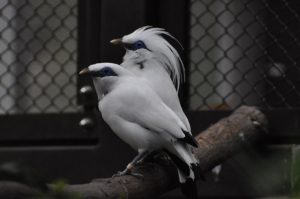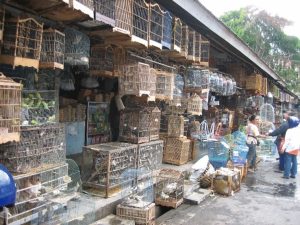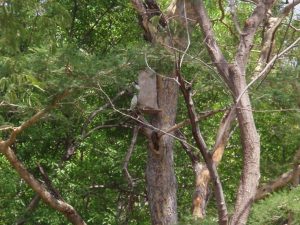Initiatives for re-introduction of Bali mynah
The Preservation and Research Center, City of Yokohama
Toshiro Shiraishi
Endangered Bali mynah
There are approximately 10,000 species of birds that currently exist worldwide, but according to the International Union for Conservation of Nature (IUCN), 1,373 species, approximately 14% of the above number, are considered to be endangered. The Bali mynah (Leucopsar rothschildi) is one such species (Fig. 1) and is designated as critically endangered (CR) on the IUCN Red List, making it one of the most endangered species.

Fig. 1. Bali mynah, endemic species of Bali, Indonesia
The Bali mynah is a species of the starling family that is endemic to Bali in Indonesia, and is a remarkably beautiful bird with pure white wings and cobalt blue coloring around its eyes. It was first discovered in 1911, about 100 years ago. At the time, it was said to have been widely distributed along the northwestern coast of Bali, but its numbers sharply decreased from the 1970s onwards. By the 1990s, wild Bali mynahs could only be seen in Bali Barat National Park, located in western Bali, and the number of birds had decreased to 20 individuals or fewer. Several reasons for this could be raised, such as the destruction of habitats due to human activities for agricultural land development in the surrounding areas, the felling of nesting trees, and water shortages during the dry season. However, the biggest reason for this critical situation was due to overhunting to keep it as a captive bird. Therefore, domestic law in Indonesia regulated the capture and export of this bird in 1971, and international trade became strictly regulated with the Washington Convention (CITES) coming into effect in 1975. However, poaching continued apace even after such measures. This was due to the high domestic demand in Indonesia in spite of these regulations, and the reason for this was that keeping beautiful and rare wild birds captive was a status symbol in Indonesian culture. The Bali mynah was particularly popular among such birds, and therefore, many individuals were illegally owned, with the individuals being bought and sold at high prices (Fig. 2).

Fig. 2. A bird market in Indonesia. Many wild birds are bought and sold here.
Reintroduction activities in national parks
Given its history of overhunting as a captive bird, many Bali mynahs were kept captive in zoos worldwide, and progress had been made in breeding programs. In 1986, the American Zoo and Aquarium Association cooperated with the Indonesian government to introduce Bali mynahs that were bred in the West to Indonesia, and to that effect, a reintroduction project in Bali Barat National Park and captive breeding plan in Subaraya Zoo located in central Java were initiated. These projects continued until 1993 but unfortunately did not yield sufficient results.
The national park then used the breeding facilities that were set up there during this time, and the individual birds that remained independently developed these as a breeding ground and made efforts toward captive breeding of the Bali mynah. In 1998, the national park restarted the plan to use the increased number of individuals to reintroduce them in the wild. They also enhanced patrols to prevent poachers, sought to improve the environment by setting up water fields that were insufficient during the dry season, and setting up birdhouses, and they have continued the reintroduction project to the present day (Fig. 3).

Fig. 3. Reintroduced individuals that were bred in the national park
Roles played by zoos
The existence of not just the Bali mynah but also that of many wild flora and fauna on earth is currently threatened by various human activities such as development, environmental pollution, introduction of exotic species, and hunting pressures. The most effective and ideal manner of protection of such wild flora and fauna is the conservation of the habitats of each ecosystem. However, developing countries, where there are a particularly high number of precious flora and fauna, face a variety of problems such as explosive human population growth, economic disparities, pollution, and conflicts, and putting such measures into practice is extremely difficult. In 1980, the IUCN, United Nations Environment Programme (UNEP), and the World Wildlife Fund (WWF) presented the World Conservation Strategy, which exemplified the concept of ex-situ (i.e., captive) conservation as a means of “Living Resource Conservation for Sustainable Development”, touching upon the potential of the “conservation of species” in zoos and aquariums. In other words, it became possible for zoos and aquariums to not only serve as recreational facilities, but as facilities that play an important role in protecting endangered species as sites for emergency evacuation and maintaining those species for long periods of time.
The Japanese Association of Zoos and Aquariums also established the Species Conservation Committee in 1988 to establish a pedigree registration ledger for rare animals kept in domestic zoos and aquariums, and also began investigations and adjustments to maintain populations that became independent in captivity. Only 32 species were targeted at the time of its inception, which has now expanded to approximately 150 species. The Bali mynah was a targeted species from the outset, with its number in captivity increasing and being maintained in a stable manner as a result of planned breeding in cooperation with domestic zoos, mainly in zoos in Yokohama City.
Bali mynah protection project
With the stabilization and increase in numbers of the Bali mynah in Japan, the Yokohama City Animal Breeding Center signed an agreement with the Ministry of Environment and Forestry of Indonesia in 2003 to provide 100 Bali mynahs that were bred in Japan to Indonesia and to cooperate with protection activities in Indonesia. From 2004 onwards, a grassroots technical cooperation project of the Japan International Cooperation Agency (JICA) was adopted, and the Bali mynah protection project materialized as a means of providing technical cooperation in various fields such as breeding and hygiene management of Bali mynahs in Indonesia, DNA analysis, field monitoring surveys, and the promotion of greening in national parks and surrounding areas.
Meanwhile, the NGO Bali Mynah Conservation Association was established in Indonesia in August 2005 following the start of the Bali mynah protection project by Yokohama City. This association promotes individual registration in Indonesia, which had been suspended to date, encourages the government to deregulate, incorporates previously illegally bred individuals into breeding plans, and achieved a legal commercial trade of birds that were bred in captivity by individual breeders. This reduced the birds’ market prices, and some effect was achieved in poaching countermeasures. Furthermore, establishing a forum for building new relationships between countries, local governments, national parks, zoos, individual breeders, nature conservation groups, and the media, which did not cooperate until now, allowed for deepened mutual understanding and the ability to implement protection activities with the cooperation of the public and private sectors.
Reintroduction to the wild and its challenges
A total of 248 birds have already been released during the period from 1998, when reintroduction projects were restarted in Bali Barat National Park, to January 2014. However, the population has unfortunately not fully recovered to date, and the number of wild individuals as of April 2014 remains at 38. Meanwhile, Nusa Penida Island, located approximately 10 km offshore to the southeast of Bali, has been conducting a Bali mynah bird release project at the private level since 2006, with government approval. Nusa Penida Island is a small island spanning about 20 km from east to west and is not the original habitat of the Bali mynah. However, the number of individuals there appears to be gradually increasing as a result of breeding, with 128 individuals recorded in the wild in a 2013 survey.
The habitats of the Bali mynah in Nusa Penida Island are in villages and their surrounding areas, but its natural environment is seemingly similar to that of Bali Barat National Park, and the factors that lead to increased numbers in the wild are unclear.
Various factors could be responsible for the increase, such as the bird release method, vegetation, and presence or absence of prey. However, one theory indicates that this may be due to the understanding and cooperation of residents toward the protection of the Bali mynah, that is, differences in the social environment.
Reintroduction to the wild is not a simple action of releasing a bird into its habitat, and various issues remain, such as habitat restoration, scientific research by monitoring after bird release, prevention of poaching, and the cooperation of residents. We hope that the public and private sectors will work together to address these issues for the protection of the Bali mynah and are able to achieve the restoration of these birds’ numbers in their original habitat.

